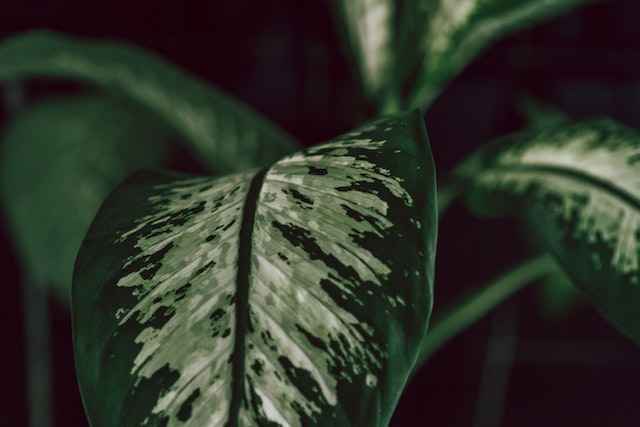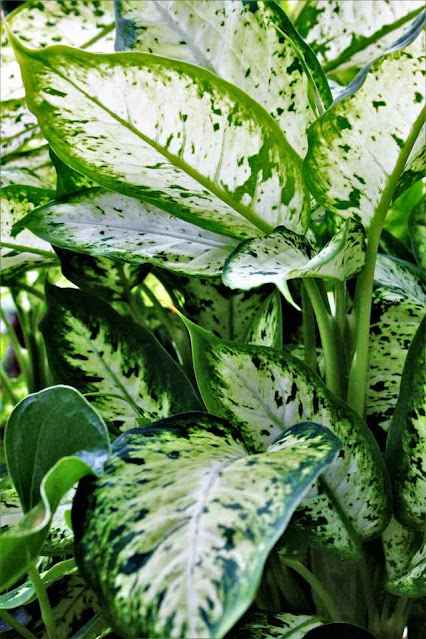Dieffenbachia: Dumb Cane Plant Features
Dieffenbachia, sometimes known as dumb cane, is a popular tropical plant native to the rainforests of Central and South America. It is well-known for its enormous, glossy, variegated leaves as well as its ability to filter interior air. Dieffenbachia plants can reach a height of 6 feet and look attractive in any room of the house.
In addition to offering gorgeous leaves, Dieffenbachia plants are known for their ability to filter the air in indoor environments by removing contaminants such as formaldehyde and xylene. They are a great option for those looking to add some greenery to their home while also improving air quality.
Dieffenbachia: Dumb Cane Plant Symptoms of Poisoning
It is critical to understand that all parts of the Dumb Cane Dieffenbachia plant are poisonous and can cause poisoning if swallowed. Symptoms of poisoning may include:
1- Oral irritation: If the plant is consumed, it may cause irritation of the mouth and throat, leading in burning, swelling, and difficulty swallowing.
2- Skin irritation: Contact with the plant can cause skin irritation such as redness, itching, and blistering.
3- Eye irritation: Contact with the plant may result in eye redness, watering, and swelling.
4- Nausea and vomiting: Taking the plant can cause nausea and vomiting.
If you or someone you know has consumed or been in contact with Dieffenbachia plant material, get medical attention right once. Keep the plant out of the reach of children and pets to avoid inadvertent consumption.
To avoid being poisoned, avoid touching the plant and constantly wash your hands afterward. If you have children or pets, keep the plant out of their reach or replace it with a non-toxic plant variety.
Dieffenbachia: Dumb Cane Plant Humidity and Air Temperature
Dieffenbachia, often known as dumb cane, is a tropical plant that grows well in high humidity and moderate temperatures. Here are some tips for maintaining the proper humidity and temperature for your Dieffenbachia plant:
1- Humidity: Dieffenbachia plants require a high degree of humidity, thus keep them in a room with a humidity level of 50% or more. You can increase the humidity around your Dieffenbachia plant by spraying the leaves on a regular basis or placing it in a humidity tray.
2- Temperature Range: Dieffenbachia plants prefer temperatures between 65 and 75 degrees Fahrenheit. Planting them in drafty or cold areas will cause the leaves to yellow and fall off.
3- Air circulation: Provide proper air circulation for your Dieffenbachia plant to avoid stagnant air and promote healthy growth. Avoid placing the plant in a location where it will be subjected to strong drafts or direct heat sources.
By maintaining the proper humidity and air temperature, you can help your Dieffenbachia plant stay healthy and thrive to its maximum potential.
Dieffenbachia: Dumb Cane Plant Meaning and Symbolism
The Dieffenbachia plant is commonly related with success, prosperity, and good fortune. It is believed to bring good fortune and abundance to the home or office where it is grown. Because the plant's lush, green leaves are connected with growth and rebirth, it's a popular choice for use in offices and other professional settings.
How to Prune Dieffenbachia Dumb Cane Plant
Pruning your Dieffenbachia, or dumb cane, plant can keep it healthy and promote new growth. Here are some recommendations for pruning your Dieffenbachia plant:
1- Use clean: sharp scissors or pruning shears to avoid introducing diseases or pests to your plant.
2- Remove any yellowing or damaged leaves: Because dead or damaged leaves sap energy from the rest of the plant, they must be removed so the plant may concentrate on healthy growth.
4- Don't over-prune: Removing too much of the plant at once may shock it and cause stress. Just remove any damaged or yellowing leaves and trim any lengthy stems as needed.
By following these guidelines, you can help keep your Dieffenbachia plant healthy and promote new development. Pruning your plant once or twice a year will help to remove any damaged or yellowing leaves and keep it in a more compact form.
Dieffenbachia: Dumb Cane Plant Leaf Yellowing
The most obvious causes of this problem include temperature variations, root rot, and maintaining your plant in a less sunny location than it should be. Aside from these three variables, it is normal for a few of your plant's leaves to turn yellow from time to time as it grows.
Dieffenbachia: Dumb Cane Plant Care and Tips
Dieffenbachia, sometimes known as dumb cane, is a common indoor plant with lovely foliage. Here are some guidelines for caring for your dieffenbachia plant:
By following these maintenance instructions, you may help your dieffenbachia plant live and enjoy its beautiful foliage for many years to come.
Dieffenbachia: Dumb Cane Plant Pot Selection
Dieffenbachia, often known as dumb cane, is a popular houseplant because of its beautiful leaf and ease of care. When selecting a pot for your Dieffenbachia, there are a few variables to consider:
1- Size: Be certain that the plant's container is not too small. Dieffenbachia can grow rather large, so choose a pot that is several inches wider than the plant's current root ball.
2- Drainage: To avoid root rot, your Dieffenbachia must have proper drainage. Use a container with bottom drainage holes to allow excess water to drain.
3- Pot Selection: Since Dieffenbachia can be sensitive to temperature changes, use a pot with insulated roots. This can be achieved with clay or ceramic pots.
4- Decor: Choose a pot that complements both the design of your home and the plant. Dieffenbachia looks great in a variety of pot styles, from modern to classic.
Dieffenbachia: Dumb Cane Plant What Should the Soil be Like?
Dieffenbachia, often known as dumb cane, is a tropical plant that prefers well-drained soil to thrive. Here are some recommendations for the optimum soil for your Dieffenbachia:
1- Use high-quality potting soil: Seek for potting soil that is specifically developed for indoor or tropical plants. These mixes are frequently made up of peat moss, perlite, and vermiculite, which provide Dieffenbachia with the right nutrient and drainage balance.
2- Do not use garden soil: Garden soil might be excessively heavy and compact for Dieffenbachia, resulting in root rot.
3- Try adding compost: Compost can help improve the nutrient quality of the soil as well as add organic matter, both of which are beneficial to Dieffenbachia.
Therefore, choosing a high-quality potting mix and avoiding over-watering are crucial to ensuring that your Dieffenbachia flourishes in the right soil conditions.
Dieffenbachia: Dumb Cane Plant Light Requirement
Dieffenbachia, often known as dumb cane, is a popular tropical rainforest houseplant that thrives in bright, indirect light. Here are some ideas for creating ideal lighting conditions for your Dieffenbachia:
1- Avoid direct sunlight: Direct sunlight can scorch and yellow Dieffenbachia leaves. Instead, place the plant in an area with bright, indirect light.
2- Direction: Rotate the plant every few days to ensure that all areas of the plant receive an equal amount of light.
3- Employ a grow light: If your home lacks natural light, you can supplement it with a grow light. Because Dieffenbachia requires a light spectrum similar to that of sunshine, choose a grow lamp with a 5500-6500K spectrum.
How to Water Dieffenbachia Dumb Cane Plant
Dieffenbachia, often known as stupid cane, is a tropical plant that prefers moist but not saturated soil. Here are some ideas for watering your Dieffenbachia:
1- Check the soil moisture: Before watering your Dieffenbachia, stick your finger about an inch into the soil to check for moisture. If the earth seems dry, it is time to water the plant. If the soil feels moist, wait a few days before watering again.
2- Use room temperature water: Water your Dieffenbachia with room temperature water to avoid startling the roots. Cold water can turn the leaves yellow and cause them to wilt.
3- Thoroughly water: While watering your Dieffenbachia, make sure to completely saturate the soil to ensure even moisture distribution. To avoid root rot, allow excess water to drain from the pot.
4- Prevent over watering: Excess moisture in your Dieffenbachia can cause root rot, so avoid over-watering. Water the plant only when the soil appears to be dry.
How to Reproduce Dieffenbachia Dumb Cane Plant
Dieffenbachia, sometimes known as dumb cane, is a tropical plant that propagates itself via stem cuttings. Here's a step-by-step guide to propagating Dieffenbachia:
1- Pick a healthy stem: Choose a healthy stem with at least one set of leaves from your Dieffenbachia plant. Pull the stem at a 45-degree angle, 4-6 inches below the bottom set of leaves.
2- Remove the lower leaves: Remove the lower leaves of the stem cutting, leaving only the top few leaves. This will help the cutting focus its attention on root development.
3- Soak the cutting in rooting hormone before planting: Before planting, soak the cut end of the stem cutting in rooting hormone. This will encourage root growth.
4- Plant the cutting in soil: Half-fill a small container with a well-draining potting mix and poke a hole in the center. Put the stem cutting into the hole, gently pressing it into the dirt. Lightly water the soil to moisten it.
5- Maintain the cutting warm and moist: Keep the container in a bright, indirect light region and the soil evenly moist. It may take several weeks or even months for the cutting to root and sprout new growth.
Dieffenbachia: Dumb Cane Plant Diseases and Pest
Dieffenbachia, sometimes known as dumb cane, is a common indoor plant with lovely foliage. It is, nevertheless, susceptible to certain diseases and pests, as do other plants. The following are some common issues that might affect dieffenbachia plants:
1- Root rot: This is a fungal disease that causes the roots of plants to soften and rot. Common causes include overwatering and poor drainage. To avoid root rot, water your dieffenbachia plant only when the soil is dry to the touch and use a well-draining soil mix.
2- Leaf spot: A fungal disease that forms small, black spots on the leaves of plants. Inadequate air circulation and high humidity are frequently to fault. To avoid leaf spot, ensure that your dieffenbachia plant has adequate air circulation and that humidity is kept to a minimum by using a dehumidifier or a fan to circulate the air.
3- Spider mites: These microscopic pests feed on plant sap, producing yellowing and withering of the leaves. Keep your dieffenbachia plant's leaves clean and dust-free to keep spider mites at bay, and spray the plant with a solution of water and mild soap to kill the mites.
4- Aphids: Aphids are little, soft-bodied insects that feed on plant sap, causing twisted, yellow leaves. To prevent aphids, keep the leaves of your dieffenbachia plant clean and dust-free, and spray the plant with a mixture of water and mild soap to kill the aphids.
If you notice any of these issues with your dieffenbachia plant, act swiftly to prevent the situation from escalating. If the plant has been substantially harmed, you may need to remove it from your home and dispose of it to prevent the illness or pest from spreading to other plants.


